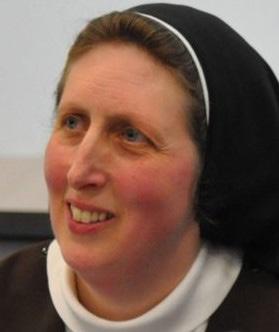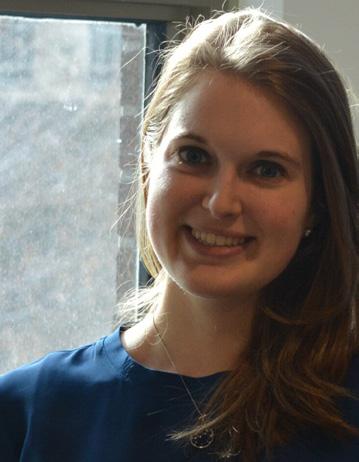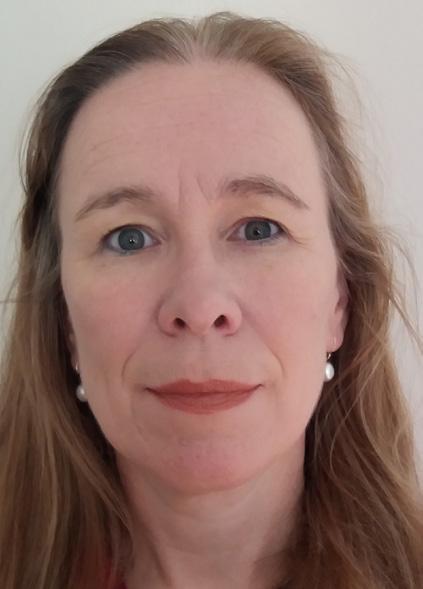
6 minute read
The Magdala Interview
Sr. Jo Robson OCD has been a member of the Carmelite community at Ware in England since 2000. She has a special interest in the writings and teaching of St. Teresa of Avila, and has published articles on this topic in a number of spiritual and academic journals. She is currently coordinator for the initial formation programme for Carmelite sisters in the UK, and is a member of the editorial team for the magazine “Mount Carmel.”

Emily VanBerkum is Associate Editor of With One Accord. For more information on her background, please visit our website.

Monica McArdle graduated from Durham University, UK with a BSc degree and post graduate certificate in Chemistry, but never actually taught full time in school, choosing instead to join Sion Catholic Community for Evangelism, working in schools and parishes across the UK. Her ministry there, for the most part, has involved exploring the use of drama, mime, dance, and sign language as modes of communication for bringing about an experience of the Christian Gospel in the lives of others. This led her, after 20 years in active mission to complete a MA in Somatic Movement and Dance Education (SMDE) at the University of Central Lancashire, where she studied embodied prayer for the research component of the MA, albeit in a secular setting. She then completed a M.Prof at the University of Chester, and is now in her fifth year of part-time PHD studies at Roehampton University, UK.
Embodied Lectio Divina
Monica McArdle

On reading Psalm 63 you might notice how it is strewn with verbs, practically one on every line. It begins with “O God, you are my God, I seek you, my soul thirsts for you,” then there’s feasting, rejoicing and clinging. Prayer in this psalm is certainly not passive but fully alive and participatory, portraying that prayer involves the whole body. I gaze with my eyes, praise with my lips, lift my hands and lie on my bed to remember and muse. Likewise, God takes an active role: for in the shadow of God’s wings I can rejoice; God fills my soul as a banquet; God’s right hand holds me fast. Perhaps this is one of the reasons why the Jerome Biblical Commentary states that “perhaps no other psalm so vividly expresses the intimate relationship of love between God and his faithful one.” What it proves is that physicality is an important part of prayer.
This perception forms the heart of my doctoral research into the role of the body in Christian prayer, with a particular focus on lectio divina . The interest arose out of my experiences as a member of a Catholic mission team working in parishes and schools, mainly in the UK. My ministry involved the use of drama, mime, dance, and sign language as modes of communication for bringing about an experience of the Gospel in the lives of others. Through this work I witnessed individuals coming to a more holistic sense of themselves and a more grounded awareness of God.
These experiences drew me to Somatic Movement Education (SME), which is a study of self from the perspective of one’s lived experience, encompassing the dimensions of body, psyche, and spirit. A fundamental premise for ‘somatic awareness’ is the understanding that body, or ‘soma,’ is an integrated whole, rather than a differentiated conglomeration of categories of mind, soul, spirit, or anatomy.1 The somatic proposition is that through the use of movement, sound, breath, touch, and imagery there evolves a capacity to notice what might be emerging through bodily sensations. It is a means of uncovering and perceiving a spectrum of knowledge that we carry within us: for, as dancer and philosopher Maxine Sheets-Johnstone explains in her book The Primacy of Movement, the action of our “tactile-kinaesthetic bodies are epistemological gateways.” Subjective knowledge can be gleaned through paying attention to the interaction of physical, mental, emotional and aesthetic/spiritual aspects of our lived experience.
www.magdalacolloquy.org
Lectio divina is a long-established form of Christian prayer which is based on a dynamic engagement with the Bible. In their book Lectio Divina: Contemplative Awakening and Awareness Benedictine spiritual directors Christine Valters Paintner and Sr. Lucy Wynkoop describe it as being “an invitation to listen deeply for God’s voice in scripture and then to allow what we hear to shape our way of being in the world.” The 12 th century Carthusian monk, Guigo II articulated lectio divina as consisting of four stages, or ‘rungs of the ladder’: lectio (reading), meditatio (meditation), oratio (prayer), and contemplatio (contemplation). In my research I matched these four components of lectio divina : reading, meditation, prayer, contemplation, with the four key somatic attributes of grounding, bones, breath and movement.
Stages of Lectio Divina
Lectio (reading), an initial acquaintance with a sacred text; meditatio (meditation), a period of sustained reflection on its words; oratio (prayer), an active response to God; contemplatio (contemplation), in the presence of the Divine.
Focuses of Somatic Awareness
Ground:- support, holding, re-orientation, witness.
Bones:- sense of self, connection, strength, presence.
Breath:- life force, bringing movement into 2-way integration.
Movement:- actualisation, expression, personalization.
The following are guidelines for integrating practice and experience.
Lectio
The first stage involves the passage being read aloud. For this, we are encouraged to become aware of the ground beneath us, allowing the fullness of our weight to drop down with gravity. The aim is to become conscious of the foundation of support and presence that is constantly with us, even when we do not think about it. Grounding, in this context, refers to the connection that each person has with the ground, creating a sense of rootedness and balance.2 An active relationship with the earth is said to develop “one’s ability to perceive and to live in ‘the here and now.’” Grounding can help a person be more present to the prayer experience, and hence move beyond mere articulation of the words.
Meditatio
Next the passage is read for a second time, in order to listen deeply for a word or phrase that beckons attention. We then ponder on this word as we sense and explore the shape of our skeleton within us. Dancer and psychotherapist, Linda Hartley writes of how locating and tracing the bones and joint spaces can “awaken the living experience.” The iteration of the phrase as the bones of the body are traced and sensed and provide a clear pathway for meditation.
The passage is read a third time while reflecting on how God is speaking through the passage. What does the scripture say about our relationship with God, and our relationship with the world? The movement of breath brings a sense of expansion between inhalation and a sense of contraction in exhalation. Questions to ask are “What am I receiving from these words?” and “What am I being invited to relinquish, let go of?” For this stage, it is not about practicing breathing techniques, but rather allowing awareness of the rhythm and shape of breath to become a vehicle for relationship in prayer.
Contemplatio
The passage is read a fourth time, as now we reflect on what response God is inviting us to make through this word. By this stage, the body has become more attuned to the sensed experiences of ground, weight, bone, and breath, and so our awareness is awakened to any seeds of movement stirring within. The felt-sensation might be slight but it is important, for as we give physical expression to it, our response to the prayer is made manifest. If we want to, we can amplify the movement: not forcing anything but allowing the prayer to flow, without struggling for words or meaning, just being and moving as you are in this moment of prayer. There is no need to consider in this prayer whether you are ‘doing it right’ for all experiences of movement are inherently authentic, only occurring in the present moment, and, therefore, valuable aspects of prayer.
Embodied lectio divina provides a gateway to the revealing of truth. Sometimes we are surprised by what we receive, and at other times touched by the unexpected. And so, we return to Psalm 63, with its plethora of verbs and active engagement to remind us that just as our bodies are in constant movement—from breathing to heart-beats and nerve-synapses firing—so too must our prayer, our communication, our connection to God.
Notes www.magdalacolloquy.org
1 as defined by ISMETA (International Somatic Movement Education and Therapy Association).
2 Grounding plays a significant role in Dance Movement Therapy, as discussed in these articles by P Tord & I. Brauninger (2015) Grounding: Theoretical application and practice in Dance Movement Therapy and B. Meekums (2002) Dance movement therapy. Creative therapies in practice.





